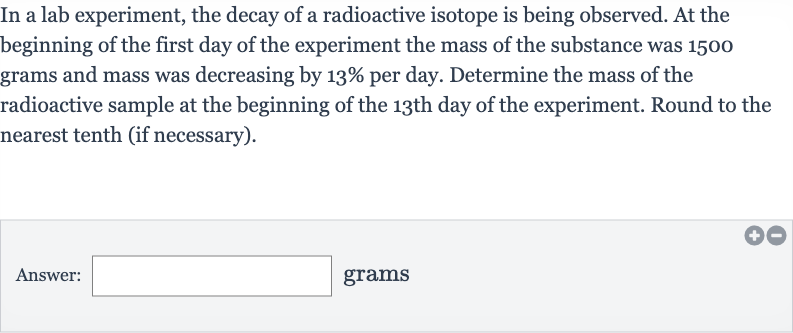AI tutor
Welcome to Bytelearn!
Let’s check out your problem:

In a lab experiment, the decay of a radioactive isotope is being observed. At the beginning of the first day of the experiment the mass of the substance was grams and mass was decreasing by per day. Determine the mass of the radioactive sample at the beginning of the th day of the experiment. Round to the nearest tenth (if necessary).Answer: grams
Full solution
Q. In a lab experiment, the decay of a radioactive isotope is being observed. At the beginning of the first day of the experiment the mass of the substance was grams and mass was decreasing by per day. Determine the mass of the radioactive sample at the beginning of the th day of the experiment. Round to the nearest tenth (if necessary).Answer: grams
- Identify initial mass and decrease: Identify the initial mass and the daily percentage decrease.The initial mass of the radioactive substance is grams, and it decreases by each day.
- Determine decay factor: Determine the decay factor.The decay factor is the percentage that remains after the decay has occurred. Since the mass decreases by each day, the decay factor is or in decimal form.
- Calculate mass after each day: Calculate the mass after each day using the decay factor.The formula for exponential decay is , where is the mass at time , is the initial mass, and is the number of days.
- Apply formula for th day: Apply the formula to find the mass at the beginning of the th day. , because we want the mass at the beginning of the th day, which is after complete days.
- Perform calculation: Perform the calculation. (rounded to four decimal places)
- Round result: Round the result to the nearest tenth.The mass of the radioactive sample at the beginning of the day is approximately grams when rounded to the nearest tenth.
More problems from Exponential growth and decay: word problems
QuestionGet tutor help
QuestionGet tutor help
QuestionGet tutor help
QuestionGet tutor help
QuestionGet tutor help
QuestionGet tutor help
QuestionGet tutor help
QuestionGet tutor help
QuestionGet tutor help
